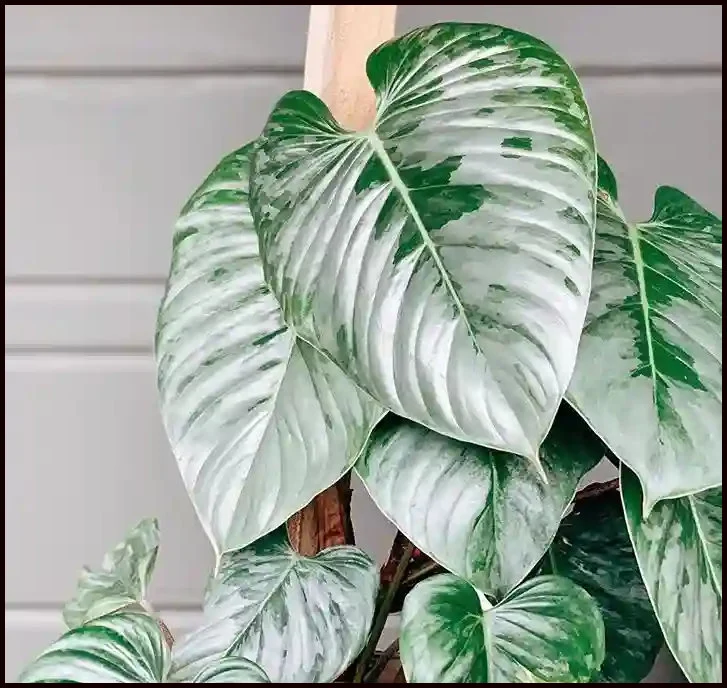The Philodendron Sodiroi is a stunning, rare species of Philodendron that is highly sought after for its unique appearance, with heart-shaped leaves that often have a glossy, dark green finish. It’s a relatively easy plant to care for, but it does have some specific needs.
1. Light Requirements
- Ideal Light: Philodendron sodiroi thrives in bright, indirect light. Direct sunlight can scorch its leaves, so it’s best to keep it in a spot with filtered light or a few feet away from a window.
- Low Light Tolerance: While it can tolerate lower light levels, its growth may slow down, and the leaves may lose some of their vibrancy in darker areas.
2. Watering
- Frequency: Water when the top 1-2 inches of soil feel dry to the touch. It’s better to underwater than overwater, as this plant is quite sensitive to root rot.
- Watering Tip: Ensure the pot has proper drainage. When you water, make sure it drains well to prevent the roots from sitting in water.
3. Temperature
- Ideal Temperature: The optimal temperature range for Philodendron sodiroi is between 65°F and 80°F (18°C to 27°C). Keep it in a warm spot but away from cold drafts or air conditioning vents, as it is sensitive to temperature fluctuations.
- Cold Sensitivity: It is not frost-tolerant, so avoid exposing it to temperatures below 50°F (10°C).
4. Humidity
- Humidity Needs: This plant thrives in high humidity, ideally between 60% and 80%. If you live in a dry climate, consider placing it on a humidity tray, using a room humidifier, or misting it regularly.
- Indoor Care: For indoor plants, maintaining humidity is key to ensuring healthy growth and vibrant foliage.
5. Soil
- Type: Well-draining, aerated soil is a must. A peat-based potting mix with added perlite, orchid bark, or coconut coir provides a good structure for healthy root growth.
- pH: Slightly acidic to neutral soil (pH 6.0-7.0) is ideal for this plant.
6. Fertilizing
- Fertilizer: Feed with a balanced liquid fertilizer every 4-6 weeks during the growing season (spring and summer). Reduce feeding in fall and winter when growth slows down.
- Organic Options: Organic fertilizers, like compost tea or worm castings, can be beneficial for promoting healthy growth without causing chemical buildup.
7. Pruning and Maintenance
- Pruning: Regularly trim any leggy or damaged vines to encourage bushier growth and to maintain the plant’s shape.
- Clean Leaves: Wipe the leaves occasionally with a damp cloth to remove dust and help the plant better absorb light.
8. Pests and Diseases
- Common Pests: can be susceptible to common houseplant pests such as spider mites, aphids, mealybugs, and scale. Inspect your plant regularly for signs of infestation.
- Control: Use insecticidal soap or neem oil to treat pests. For fungal issues like powdery mildew, make sure the plant is not too crowded and has adequate airflow.
9. Repotting
- Frequency: Repot your sodiroi every 1-2 years or when it becomes root-bound. Choose a pot that is 1-2 inches larger than the current one to allow room for growth.
- Signs: If the plant’s growth slows or roots start to emerge from the drainage holes, it may be time to repot.
10. Propagation
- How to Propagate: The easiest way to propagate is by taking a stem cutting that includes a node (the small bump where leaves and roots grow). Place the cutting in water or directly in moist soil. After a few weeks, it should develop roots and can be planted into its own pot.
11. Toxicity
- Toxic to Pets: Like many Philodendrons, the sodiroi is toxic to pets (dogs and cats) if ingested. Be sure to keep it out of reach of curious animals.
12. Growth Habit
- Vining Growth: is a vining plant, meaning it can be grown as a trailing plant or trained to climb a trellis or support. You can provide a moss pole or other support if you want to encourage vertical growth.
With its beautiful, glossy leaves and relatively easy care requirements, the Philodendron sodiroi can make a stunning addition to your indoor plant collection. Just provide it with the right light, water, and humidity, and it will thrive!


